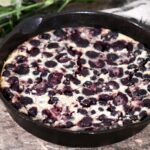Fermented Fruit Clafoutis
Fermented fruit clafoutis is a delicious way to use leftover fruit from making wine, cider, and mead. It’s also perfect for fruit preserved with fermentation.
- Prep Time: 10 minutes
- Cook Time: 45 minutes
- Total Time: 55 minutes
- Yield: Serves 6 to 8 1x
- Category: Dessert
- Cuisine: French
- Diet: Gluten Free
Ingredients
Units
Scale
- 3 cups of fermented fruit (see above for suggestions)
- 4 eggs
- 1/2 cup of sugar
- 1 cup of milk
- 2 tsp vanilla
- 3/4 cup of flour (all-purpose or gluten-free)
- A pinch of salt
Instructions
- Preheat the oven to 375 F (190 C). Grease a 10-inch deep pie plate or oven-safe skillet. This is a liquid batter, so don’t use a spring-form pan.
- Drain the fermented fruit from its liquid. I recommend saving the liquid from fermented fruit. It’s delicious mixed into sparkling water or cocktails. Set the fruit aside to drain while you put together the rest of the clafoutis.
- Beat the eggs and sugar together in a medium-sized bowl until frothy, about 2 minutes. Beat in the milk and vanilla. Then stir in the flour and salt.
- Spread the fruit over the bottom of a greased pie plate or oven-safe skillet. Pour the batter over the fruit. Place the pie plate on a baking sheet and put it in the oven. Bake for 10 minutes. Reduce the heat to 350 F (180 C) and cook for another 35 minutes, until a toothpick inserted in the center comes out clean.
- It will come out of the oven puffed up like a soufflé. It will deflate as it cools. Allow it to cool for at least 20 minutes before serving. It can be served warm or cold. Feel free to serve the clafoutis with a dusting of icing sugar if you would like a bit more sweetness.
- Store the leftovers in an air-tight container in the fridge for up to 3 days.
Notes
- The flour in this dessert is mainly for thickening. There is no need to include extra binders like xanthan gum in gluten-free flour. Just use whatever grain-based flour you have in your kitchen. I’ve made this recipe with oat flour, buckwheat, and white rice (for the photograph).
- This recipe is perfect for leftover fruit from brewing whole-fruit wine or cider. It’s also perfect for fruit preserved with fermentation. See the sections above for details.
Nutrition
- Serving Size: One slice
- Calories: 219
- Sugar: 12.2g
- Sodium: 79mg
- Fat: 5.5g
- Saturated Fat: 1.7g
- Carbohydrates: 20.5g
- Fiber: 1g
- Protein: 7.9g
- Cholesterol: 187mg
